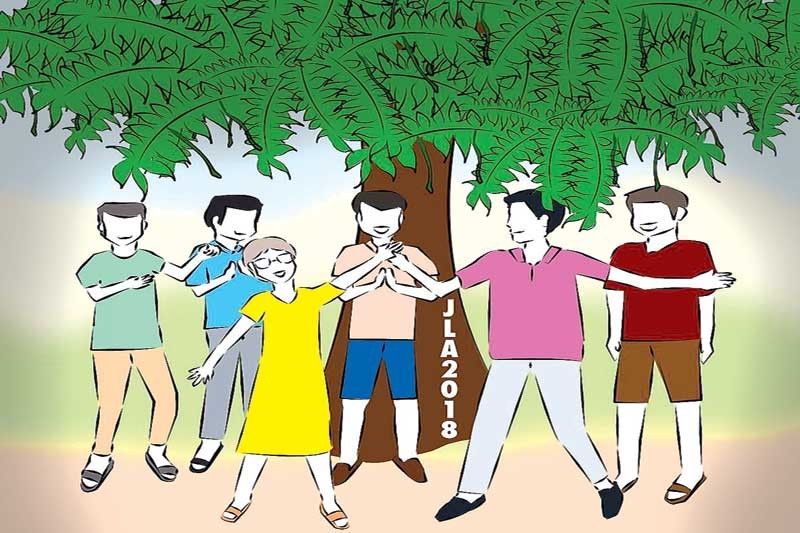The night we danced with Nanay under the himbaba-o tree


On Mother’s Day, my four brothers and I surprised our Nanay with an impromptu dance after our dinner at home. It was a night we will never forget.
Just after dusk in our family compound, we gathered for Mother’s Day dinner. A slender wooden table was readied under the himbaba-o tree, a ubiquitous witness to many a celebration at home. Nearby was a two-burner stove where a big casserole of hamonado was simmering, splendid in the aroma of pineapple juice, pork liver and the special sauce Nanay mixed in the dish. On the other burner, Kuya Gaddie, the second in the brood of five boys, was cooking his birthday noodles (it was also his 50th birthday that day) with Chinese chorizo, bagnet, and chicken liver.
That night, the breeze was kind and generous, unlike the day before when the summer heat was oppressing. From time to time, a yellow leaf of himbaba-o or the red-orange flowers of our narra tree in the garden would end up in the vat of pancit and Kuya Gaddie would busy himself protecting his kitchen creation. Earlier that day, he had cooked menudo with raisins. He also ordered a bilao of yummy puto pao (ricecake with minced pork) from a neighbor named Nessy.
When dinner was ready, we gathered at the table. Like all our family dinners, the celebration we had that night was replete with jokes and non-stop storytelling. Every member of the family had a story to tell. (We don’t run out of new stories, both mundane and meaningful, to tell each other every day.)
“Ay, baakin na ang pakwan (Slice the watermelon),” Nanay broke in the middle of the feast, her hand holding on to a glass of ice-cold melon juice. Kuya Ronnie, the eldest, stood up, walked a few steps to his house, one of the three in our compound, and brought out the pakwan as big as two basketballs combined.
Rod, the youngest, brought out the chocolate cake, put two candles on it for Nanay and Kuya Gaddie to blow. Happy birthday for Kuya Gaddie; and happy birth-giving day for Nanay. “One, two, three,” we counted after singing “Happy birthday.” And together, Nanay and Kuya Gaddie blew the candles on the cake.
Odick, the fourth in the brood and whose dancing skills were on fleek, asked his daughters Gabby and Alex to bring out the portable high-volume speaker and play some music. And a song was played — O Maliwanag na Buwan — and my brothers and I broke into a dance, taking turns to swing, sway and waltz with our 73-year-old mother.
Kuya Ronnie, the coolest among us, took Nanay first to the “dance floor,” which was littered with the leaves from the trees in our yard, including the dried leaves from the robust camachile and the towering buboy (local cotton tree) in the neighbors’ houses. It was unusually windy that summer night; even the weather cooperated, celebrated with us.
Kuya wore his smile as he danced with Nanay. His happiness was made more pronounced by his moustache. He’s known in the neighborhood as “Barangay” because when he was younger, he would wake up early, go up a moored banca in Laguna Lake and cordially ask for fish and shrimps from the fishermen in Gulod who had spent the night in the lake gathering suso (little snails), which was staple for their ducks. The fishermen from the neighborhood were kind they would allow Kuya to gather from their haul and we would have food on the table for the whole day while our parents worked in the rice field as kasama (tenants). Oh, a “barangay” in our barrio of Gulod is a term for someone who can get something for free to feed his family.
Kuya Gaddie, the birthday boy who is always ready with a punch line, was next to dance with Nanay. He wrapped our mother in his embrace and swayed her like she had never been swayed before.
We call Kuya Gaddie “Anda” because when he was eight or nine years old, he claimed to see the spirit of our late grandmother, Lola Ilay, dancing on top of the tall cotton tree. He was on his way home one afternoon after helping our parents in the rice field when he said he saw the image of our lola. The local term for his experience is “namatanda.” Thus, “Anda.” He arrived home with high-grade fever and was brought to a magtatawas. He got well the following day.
The middle child in me was egged next to the dance floor. I kissed my mother’s hand and did a curtsy before we danced. I pressed my cheek against Nanay’s and I smelled my childhood. Those were the days when she would call me Buddha because I resembled the plump and white Buddha alkansya she had at home.
Odick, arguably the funniest of us all, was all comical when he got the hand of Nanay from me. He’s tall and burly and he lifted Nanay who melted in his arms in mirth. Her laughter reminded us all how Odick earned the sobriquet “Sunog.” When Odick was in grade school, he heard our mother talking to a relative that she would burn the nests of the native chickens in our silong because they started to spawn hanip (almost microscopic fleas). Very early in the morning, Odick, earnest in his desire to help, set the nests on fire — without taking them out in the vacant lot beside our house. So, when the nests were burning, our house, made of Lawanit wood, was threatened, too. Thankfully, my mother reached for a pail of water (including the arinola) and doused the imminent fire. Our humble house was saved and Odick forever earned the moniker.
Rod, both funny and strict (he’s a public school teacher), was the last to dance with Nanay. By this time, O Maliwanag na Buwan had played a few more times. He wrapped Nanay in his arms and they danced the night away. The tables have turned because when Rod was two years old, Nanay wrapped him in her embrace on the way to PGH (Philippine General Hospital). His stomach was bloated and he was in pain. Our young minds could vaguely grasp his medical condition but what we knew was it happened shortly after Rod accidentally swallowed a 25-centavo coin. But it was not the coin that caused him to be ill. It was a serious case that had Rod confined in a PGH ward for more than a month. Our parents were with him in the hospital and we were left in the care and guidance of our Kuya Ronnie. Rod survived the operation and from then on, he earned the nickname PGH.
O Maliwanag na Buwan continued to play and we had another round of dancing with Nanay. On a night that was quiet, we chose to revel in each other’s company. Over a feast, we celebrated our family. When Tatay was alive, he would always say in the vernacular that the greatest legacy one could leave behind is a happy family. “Legacy,” he said in Tagalog, “is not about a billion pesos earned; it’s about a billion beautiful memories created with the loved ones.” So, every day, we choose to celebrate our family while the time still counts and the moment still matters.
On Mother’s Day, we feted Nanay. She raised five boys and made sure we would love each other. In the long days of want, she taught us to sing kundiman songs among other ditties. Her sinigang sa bayabas na buto-buto or bangus still creates a riotous reception at our dining table. At 73, she has never stopped becoming the moon to us, her stars.
That night, with the himbaba-o as our witness, we showed Nanay that if we would be born again, we would still lovingly choose her to be our mother! And we would still dance to O Maliwanag na Buwan. *
(For your new beginnings, e-mail me at bumbaki@yahoo.com. I’m also on Instagram @bumtenorio. Have a blessed Sunday!)















